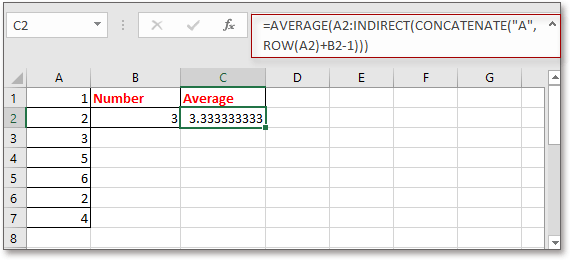Как да дефинирам диапазон въз основа на друга стойност на клетка в Excel?
Изчисляването на диапазон от стойности е лесно за повечето потребители на Excel, но опитвали ли сте някога да изчислите диапазон от стойности въз основа на числото в конкретна клетка? Например има колона със стойности в колона A и искам да изчисля броя на стойностите в колона A въз основа на стойността в B2, което означава, че ако е 4 в B2, ще осредня първите 4 стойности в колона A, както е показано на екранната снимка по-долу. Сега представям проста формула за бързо дефиниране на диапазон въз основа на друга стойност на клетка в Excel.
Определете диапазон въз основа на стойността на клетката
 Определете диапазон въз основа на стойността на клетката
Определете диапазон въз основа на стойността на клетката
За да направите изчисление за диапазон въз основа на стойност на друга клетка, можете да използвате проста формула.
Изберете празна клетка, в която ще изведете резултата, въведете тази формула =СРЕДНО(A1:INDIRECT(CONCATENATE("A",B2))), и натиснете Въведете ключ за получаване на резултата.
1. Във формулата A1 е първата клетка в колоната, която искате да изчислите, A е колоната, за която изчислявате, B2 е клетката, на базата на която изчислявате. Можете да промените тези препратки според нуждите си.
2. Ако искате да направите обобщение, можете да използвате тази формула =SUM(A1:INDIRECT(CONCATENATE("A",B2))).
3. Ако първите данни, които искате да дефинирате, не са в първия ред в Excel, например в клетка A2, можете да използвате формулата по следния начин: =СРЕДНО(A2:INDIRECT(CONCATENATE("A",RED(A2)+B2-1))).
Бързо преброяване/сумиране на клетки по фон или цвят на формат в Excel |
| В някои случаи може да имате диапазон от клетки с множество цветове и това, което искате, е да преброите/сумирате стойности въз основа на един и същи цвят, как можете бързо да изчислите? с Kutools за Excel's Брой по цвят, можете бързо да правите много изчисления по цвят, а също така можете да генерирате отчет за изчисления резултат. Кликнете за безплатен пълнофункционален пробен период след 30 дни! |
 |
| Kutools за Excel: с повече от 300 удобни добавки за Excel, безплатни за изпробване без ограничение за 30 дни. |
Най-добрите инструменти за продуктивност в офиса
Усъвършенствайте уменията си за Excel с Kutools за Excel и изпитайте ефективност, както никога досега. Kutools за Excel предлага над 300 разширени функции за повишаване на производителността и спестяване на време. Щракнете тук, за да получите функцията, от която се нуждаете най-много...

Раздел Office Внася интерфейс с раздели в Office и прави работата ви много по-лесна
- Разрешете редактиране и четене с раздели в Word, Excel, PowerPoint, Publisher, Access, Visio и Project.
- Отваряйте и създавайте множество документи в нови раздели на един и същ прозорец, а не в нови прозорци.
- Увеличава вашата производителност с 50% и намалява стотици кликвания на мишката за вас всеки ден!
